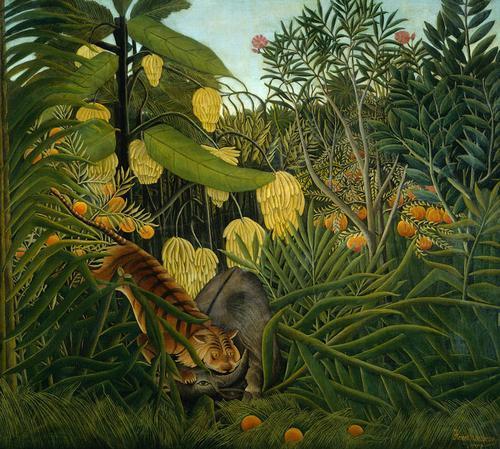Henri, from Laval, France, and dubbed “Le Douanier” (customs officer) after his occupation found primitive art late in life. He at once mastered a landscape formula, and beginning after 1904 created more than twenty large fanatistic jungle paintings. They evidence his mastery of a formal language, oblivious of convention, that owes nothing to traditional methods. The images, smooth, vivid, and clearly defined, are flat and fluid against dense but dimensionless greenery, and although unreal and extraordinary, are rendered in meticulous botanical detail.
|
|
 Viewer |
Fight between a Tiger and a Buffalo, 1908 oil on fabric The Cleveland Museum of Art Although Henri Rousseau never ventured outside France, he gave this painting a tropical mood derived from reading travel books and from frequent visits to the Paris botanical garden, the Jardin des Plantes. He surrounded the image of a tiger attacking a buffalo with a fantastic jungle scene of sharply outlined hothouse plants enlarged to frightening proportions. Botanical accuracy was of little importance-note the bananas growing upside down. Rousseau was working on this painting when he was arrested and imprisoned for fraud in December 1907. Officials granted him an early release to finish it for exhibition at the Salon des Indépendants, where this major composition, one of the artist's largest and most important, appeared in March 1908. This painting is a culminating work in the series of large, jungle scenes Rousseau painted between 1904 and 1910.1 The theme offered him an opportunity to give free reign to his imagination and to express his fascination with exotic subjects. Like Gauguin, Rousseau sought relief from mundane reality and European rationalism. Rousseau's mastery over his self-invented style, for which he is sometimes credited as the greatest native artist. Every leaf, branch, and grass blade is rendered with extraordinary precision, producing a hyper-realism of solid, weighty, tightly integrated forms. Italian artist Ardengo Soffici (1879-1964) watched Rousseau at work on this canvas and remarked on his highly unusual, intuitive method of painting each color separately, first applying the greens, then the blues, then the reds, and so forth. |
| Centennial of Independence | Football Players | Tiger and Bull | Fortifications | Surprised | Fight | Exotic Landscape |
| Renowned Artists Gallery index (61 galleries)
Other Parts of the Permanent Gallery | ||
| Digital Color Winners 2004 and 2005
Digital Color Winners 2002 and 2003 Digital Color Winners 1999, 2000 and 2001 |
Watercolor Painters
Oil Painters Pen and Pencil Artists |
Photographers
Sculptors Authors |